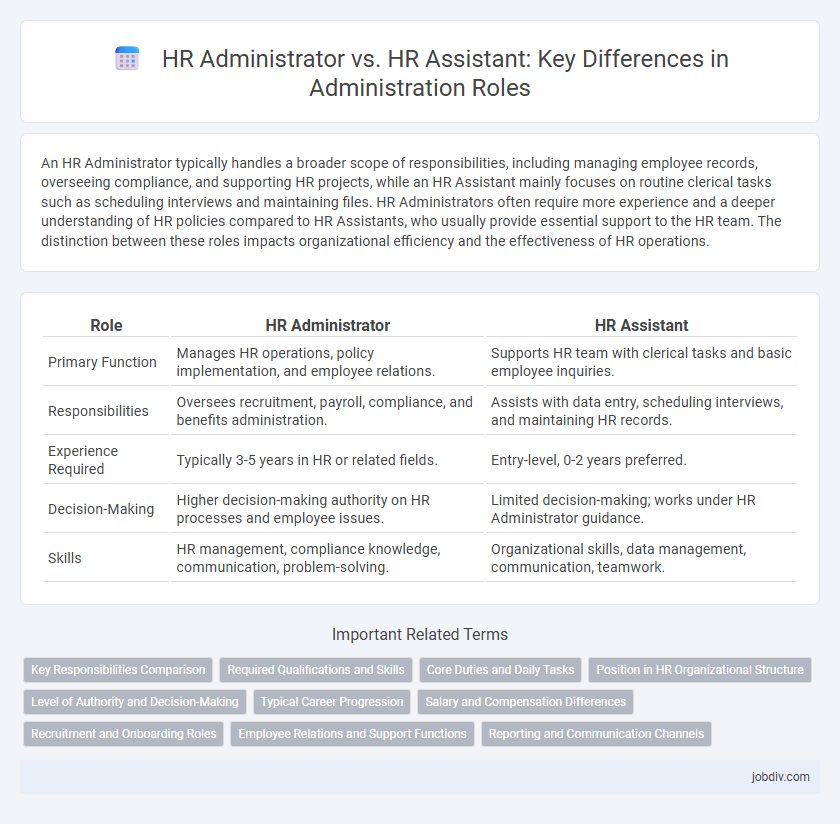An HR Administrator typically handles a broader scope of responsibilities, including managing employee records, overseeing compliance, and supporting HR projects, while an HR Assistant mainly focuses on routine clerical tasks such as scheduling interviews and maintaining files. HR Administrators often require more experience and a deeper understanding of HR policies compared to HR Assistants, who usually provide essential support to the HR team. The distinction between these roles impacts organizational efficiency and the effectiveness of HR operations.
Table of Comparison
| Role | HR Administrator | HR Assistant |
|---|---|---|
| Primary Function | Manages HR operations, policy implementation, and employee relations. | Supports HR team with clerical tasks and basic employee inquiries. |
| Responsibilities | Oversees recruitment, payroll, compliance, and benefits administration. | Assists with data entry, scheduling interviews, and maintaining HR records. |
| Experience Required | Typically 3-5 years in HR or related fields. | Entry-level, 0-2 years preferred. |
| Decision-Making | Higher decision-making authority on HR processes and employee issues. | Limited decision-making; works under HR Administrator guidance. |
| Skills | HR management, compliance knowledge, communication, problem-solving. | Organizational skills, data management, communication, teamwork. |
Key Responsibilities Comparison
HR Administrators oversee strategic HR functions such as policy implementation, employee relations, and compliance management, ensuring alignment with organizational goals. HR Assistants support daily HR operations by managing records, scheduling interviews, and handling routine employee inquiries. The HR Administrator typically holds higher accountability for decision-making, while the HR Assistant focuses on administrative and clerical tasks within the HR department.
Required Qualifications and Skills
HR Administrators typically require a bachelor's degree in human resources, business administration, or a related field, along with experience in employee relations, compliance, and HR software proficiency. HR Assistants usually need an associate degree or relevant certification, strong organizational skills, and familiarity with basic HR functions such as recruitment support and record-keeping. Both roles demand effective communication, attention to detail, and the ability to handle confidential information with discretion.
Core Duties and Daily Tasks
HR Administrators oversee recruitment processes, employee record management, and policy implementation while ensuring compliance with labor laws. HR Assistants provide support through scheduling interviews, maintaining personnel files, and facilitating communication between staff and management. Both roles require proficiency in HR software, but HR Administrators handle higher-level decision-making and strategic planning.
Position in HR Organizational Structure
An HR Administrator typically occupies a mid-level position within the HR organizational structure, overseeing routine HR functions and ensuring compliance with company policies. In contrast, an HR Assistant holds an entry-level role, providing clerical support and assisting with basic employee record management. The HR Administrator often reports to HR Managers, whereas HR Assistants usually report directly to HR Administrators or Specialists.
Level of Authority and Decision-Making
HR Administrators typically hold higher authority and play a key role in decision-making processes related to recruitment, employee relations, and compliance, while HR Assistants provide essential support by managing administrative tasks and maintaining employee records without engaging in strategic decisions. The HR Administrator often supervises HR Assistants and has the responsibility to implement policies and oversee daily HR operations. Authority levels for HR Administrators influence organizational HR strategy, whereas HR Assistants operate under direct supervision with limited autonomy.
Typical Career Progression
An HR Administrator typically oversees compliance, payroll, and employee records, serving as a mid-level role with opportunities to advance into HR Specialist or HR Manager positions. An HR Assistant supports administrative HR tasks, such as scheduling and data entry, often beginning their career with potential progression to HR Administrator or HR Coordinator roles. Career advancement in HR usually depends on gaining experience, certifications like PHR or SHRM-CP, and developing expertise in areas such as recruitment or employee relations.
Salary and Compensation Differences
HR Administrators typically earn higher salaries than HR Assistants due to their increased responsibilities in managing employee relations, payroll, and benefits administration. On average, HR Administrators can expect a compensation range of $50,000 to $70,000 annually, whereas HR Assistants generally earn between $35,000 and $50,000. Salary variations depend on factors such as geographic location, level of experience, and company size.
Recruitment and Onboarding Roles
HR Administrators manage the recruitment process end-to-end by coordinating job postings, screening candidates, and facilitating interviews, ensuring compliance with company policies and labor laws. HR Assistants support recruitment by handling administrative tasks like scheduling interviews, maintaining candidate databases, and preparing onboarding documents. During onboarding, HR Administrators oversee orientation programs and policy training, while HR Assistants manage paperwork and assist new hires with initial setup tasks.
Employee Relations and Support Functions
HR Administrators manage complex employee relations by implementing policies, resolving conflicts, and ensuring compliance with labor laws, while HR Assistants provide essential support functions such as record-keeping, scheduling interviews, and facilitating communication between staff and management. The HR Administrator plays a strategic role in fostering workplace harmony and enforcing organizational standards, whereas the HR Assistant focuses on administrative tasks that streamline HR operations. Effective collaboration between both roles enhances employee engagement and operational efficiency within the human resources department.
Reporting and Communication Channels
HR Administrators oversee comprehensive reporting processes, ensuring accurate data consolidation and timely submission to senior management, while HR Assistants support these tasks by gathering and inputting employee information. Communication channels for HR Administrators often involve direct interaction with department heads and executives, facilitating strategic decision-making. HR Assistants primarily handle routine internal communications within the HR team and serve as a liaison for employee inquiries.
HR Administrator vs HR Assistant Infographic

 jobdiv.com
jobdiv.com